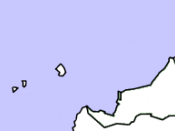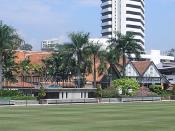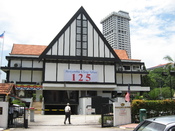IntroductionMalaysian Employers Federation (MEF) is the central organization of private sector employers in Malaysia recognized nationally, regionally and internationally for employers which promote and safeguards the rights and interests of employers since year 1959. MEF provides a forum for consultation and discussion among members on matters of common interest, and seeks for the adoption of sound principles and practices of human resource and industrial relations through information, advice, research and information, training and other activities.
Objectives1.Representation of members at conciliation and mediation proceedings and at proceedings before Labour and industrial court.
2.Provision of advisory/ consultancy service, at all levels.
3.Provision of professional training and related activities through the establishment of an MEF Academy.
4.Research and development of best practices in all relevant fields.
5.Advocacy and representation of employerÃÂs interests and business needs at national regional and international fora.
Mission1. To promote the development of excellence in human resource management to enable employers meet current and future business challenges.
2.To promote productivity through inter alia harmonious employer/employee relationship.
3.To promote and represent the interest of employers at national, regional and international for a4.To promote and represent the business interests of employers at national, regional and international fora.
VisionTo be the premier employersÃÂ representative at national, regional and international levels and to be leader in the development of human resources and the promotion of good employment practices and harmonious industrial relations with a view to achieving national objectives.
History of MEFIn year of 17 April 1959 as many 60 employers gathering at Selangor Club, Kuala Lumpur to inaugurate the Federation of Malaya Industrial & Commercial Employers' Consultative Association. The objective of establishing an association of employers was stated by the Chairman, Mr. I.P. Bruce of Shell, in the following words:"The path towards progress and development along which the Federation of Malaya has chosen to travel is that of a private enterprise economy operating within the policy laid down by a democratically elected Government... It is only right that the Government should expect the interests of employers to be represented by a recognised and far-reaching association, and that it should be able to turn to that body for advice and consultation on all matters pertaining to the functioning of the free enterprise system. There are certain conditions indispensable to the proper functioning of the free enterprise, and it is the responsibility of employers to ensure that the Government maintains them."The Association was established with 73 founder-members and one affiliate member, the Pan Malayan Road Transport Operators' Association. Mr. R.J.E. Price of Malayan Tobacco Company was its first Chairman. Y.B. Tan Sri Dato' S.O.K. Ubaidulla was elected Vice Chairman and he became Chairman in 1963. Subsequently when the Association changed its name to the Malayan Employers Consultative Association (MECA) he remained in that office until December 1982. In recognition of his untiring and dedicated service in the interest of the Association. he has been made the Hon. Life President.
In May 1962 the Malayan Council of Employers' Organisations (MCEO) was formed comprising three constituent members, viz. the Malayan Employers' Consultative Association (MECA), the Malayan Agricultural Producers Association (MAPA) and the Malayan Mining Employers' Association (MMEA). MCEO was officially recognised as the apex employers' organisation in the country serving as a forum for consultation and coordinated thinking among employers on matters of common interest. It soon became apparent, that the membership base of a central organisation had to be expanded to reflect the structural changes that were taking place in the national economy and to allow for a greater diversity of employer representation and functional effectiveness. A strategic realignment was essential to enhance the effectiveness of the Association. This view was also reflected in the Labour Minister's speech to the MCEO in 1976 when he said:"Finally, I would like to say here that Government would like to see MCEO develop into a strong pinnacle of employers organisations in this country, whose influence would pervade all aspects of management, so as to help establish practices and conduct in labour-management relations which are conducive to the maintenance of industrial peace and harmony."The constituent members unanimously agreed to dissolve MCEO with effect from 31 December 1977 and to transform MECA into a new apex employer organisation called the Malaysian Employers Federation (MEF). The membership of MEF included all the direct members of MECA which became known as Ordinary members and six employer trade unions which became then Association members. The change involved a structural reshuffle the aim of which was to reflect the image of a strengthened, closely-knit and united central employers organisation. This was achieved by uniting the existing employer organisations together with individual corporations in the private sector under a common umbrella thus emphasising the status of the Federation as the most representative employer organisation in the country.
At the beginning of 1978 the number of members totalled 877. Now, 28 years later there are 4,058 members with membership comprising all sectors of commerce and industry and the professions, large and small. Presently the Head Office of the Secretariat is housed at its own premises, with Regional Offices in Penang, Johor Bahru, Kuantan and Ipoh.
bibliographiesMalaysian employee federation http://www.mef.org.my/public/aboutmef.aspx acess at 10 march 2009balakrishnan parasuranam (2004), malaysia industrial relations: a critical analysis, pearson education 1st edition





